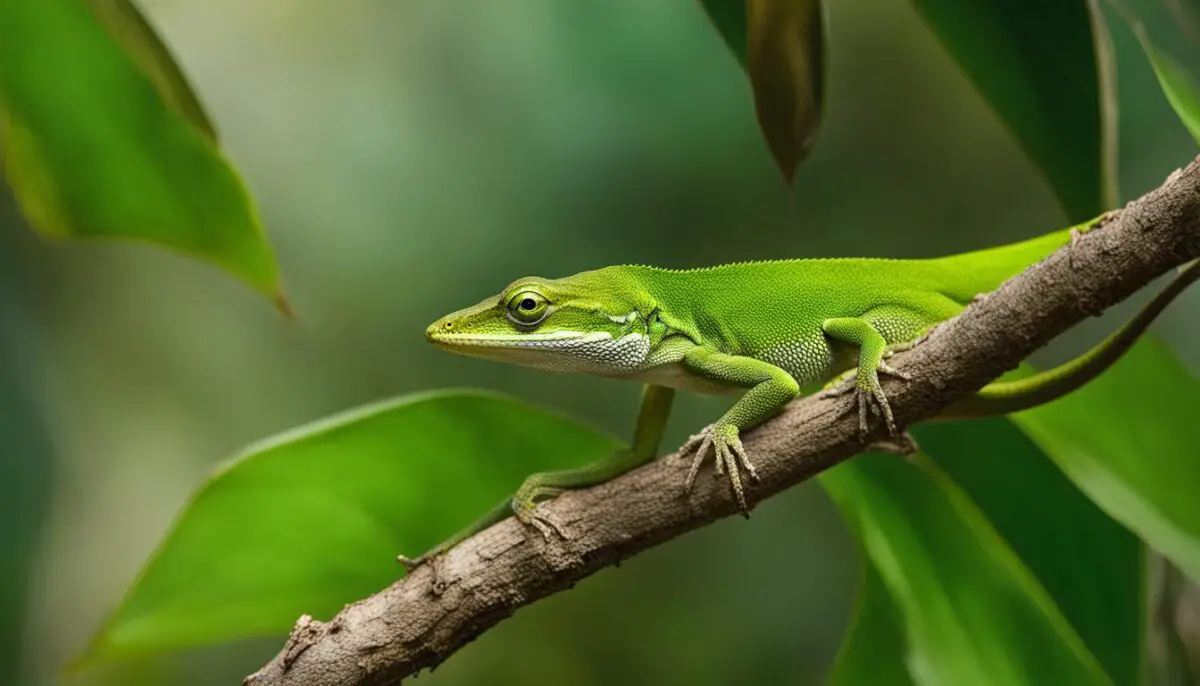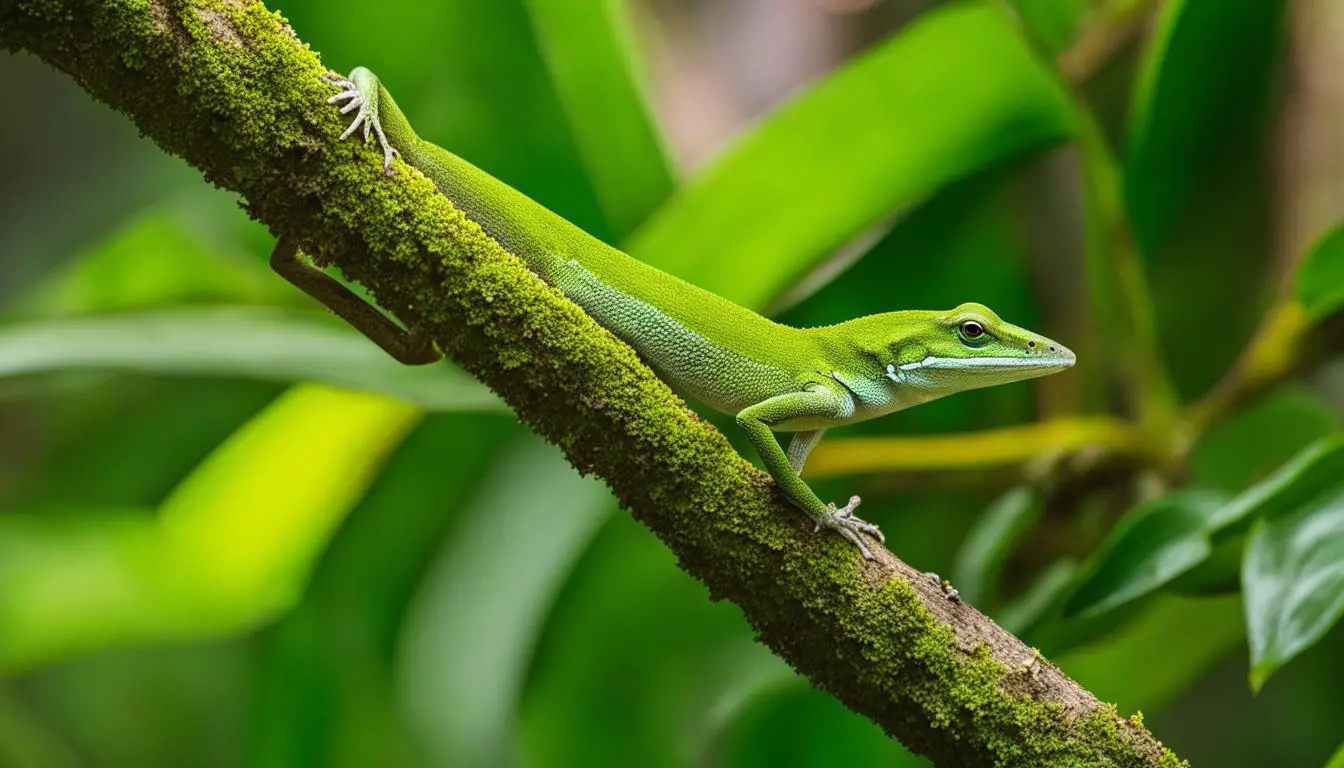Welcome to our comprehensive guide on caring for Cuban Anole lizards. If you’re fascinated by these stunning creatures and considering them as pets, you’ve come to the right place. In this guide, we will provide you with all the information you need to create a suitable habitat and ensure the proper care for your Cuban Anole lizard.
Cuban Anole lizards, scientifically known as Anolis equestris, are medium-sized diurnal reptiles native to Cuba. They are the largest species of anole, reaching up to 17 inches in length. While they may not be commonly found in the US pet trade, with the right care, they can make impressive display animals.
To provide the best possible care for your Cuban Anole lizard, it is important to understand their habitat requirements and specific needs. Let’s dive into the details and discover how to create a suitable environment for these unique reptiles.
Key Takeaways:
- Cuban Anole lizards are the largest species of anole, reaching up to 17 inches in length.
- They require a spacious enclosure with a recommended size of 24”L x 24”W x 48”H.
- Exposure to UVB light and bright plant grow lights is crucial for their health.
- Temperature should be maintained at 90-95°F for basking and 75-80°F for cooler areas.
- Humidity levels should be kept between 70-80%.
Cuban Anole Lizard Appearance and Behavior
The Cuban anole lizard (Anolis equestris) is a fascinating reptile with distinctive characteristics and behaviors. Let’s explore its appearance and behavior in more detail.
Appearance
The Cuban anole lizard is typically bright green in color, adorned with striking yellow markings. Its large, triangular head and prominent eyes give it a distinctive look. With a thick neck and a long, whiplike tail, the Cuban anole exudes elegance. Males have a more pronounced flap under their chin, which they extend and fill with air during mating or while warding off other males. Females also possess this flap but to a lesser extent. On average, the Cuban anole lizard measures around 6 inches in length, although it can grow up to an impressive 18 inches, making it the largest known anole species.
Behavior
The Cuban anole lizard is primarily an arboreal species, spending most of its time in trees. This lizard is known for its agility and speed, as it can be remarkably difficult to catch. Interestingly, the Cuban anole lizard can change its color slightly depending on its mood and the temperature and humidity levels of its environment. Male Cuban anoles are territorial, while groups of anoles in the wild typically comprise mostly females with only one male.

| Appearance | Behavior |
|---|---|
| Bright green color with yellow markings | Primarily arboreal, spending most of their time on trees |
| Large, triangular head with prominent eyes | Agile and fast, difficult to catch |
| Thick neck with a pink dewlap | Can change color slightly based on mood and environment |
| Long, whiplike tail | Male Cuban anoles are territorial |
Cuban Anole Lizard Habitat Requirements
Creating the perfect habitat for your Cuban anole lizard is essential to ensure its health and well-being. The ideal terrarium size for a single anole should be at least 10 gallons and 18 inches tall. If you plan to house multiple anoles, a larger terrarium is recommended to accommodate their needs.
The bottom of the habitat should be lined with a suitable substrate such as coconut fiber, moss, or bark bedding. This will provide a comfortable and natural surface for your lizard to explore and burrow.
Lighting is crucial for Cuban anole lizards, as they require UVB light to thrive. You should provide a UVB light source specifically designed for reptiles to ensure they receive the necessary UVB radiation for proper bone development.
The temperature within the habitat is crucial for maintaining the health of your Cuban anole. It is recommended to have a basking area with a temperature range of 85-90°F and a cooler area in the range of 75-85°F. This temperature gradient will allow your lizard to regulate its body temperature as needed.
Humidity levels should be between 60-80% to replicate the natural habitat of Cuban anole lizards. Regular misting of the enclosure and the use of a hygrometer to monitor humidity levels will help create a suitable environment.
Your habitat should include hiding places like rocks or wood to provide your lizard with security and a sense of safety. Live plants, branches, and other climbing materials will also enrich your lizard’s environment, allowing for natural behaviors and an engaging space to explore.
By providing a habitat that meets the specific needs of your Cuban anole lizard, you are ensuring that it can thrive and lead a healthy and happy life.
Feeding and Supplements for Cuban Anole Lizards
Cuban anole lizards are insectivorous and have specific dietary needs to thrive in captivity. Providing them with the right food and supplements is crucial for their overall health and well-being.
Diet
As insectivores, the primary food source for Cuban anole lizards is live insects. The diet should consist of gut-loaded insects, such as crickets, which are fed a nutritious diet before being offered to the lizards. Adult lizards should be fed 2-5 crickets a couple of times a week. It’s important to consider the size of the insects relative to the lizard’s size to avoid any potential choking hazards or digestive issues.
Treats can also be included in their diet occasionally. Mealworms, hornworms, or phoenix worms can be offered as treats to provide additional variety and stimulation for the lizards. However, treats should be given sparingly and not make up a significant portion of their diet.
Supplements
In addition to a varied insect diet, Cuban anole lizards require calcium and vitamin supplements to prevent deficiencies. These supplements can be dusted onto the insects before feeding them to the lizards. Calcium is especially important for proper bone growth and development, while vitamin supplements help ensure overall nutritional balance.
Hydration
Ensuring proper hydration is essential for Cuban anole lizards. They obtain most of their water from the moisture content of the insects they consume. However, supplemental hydration can be provided through misting the enclosure with water and offering a shallow water dish. The water dish should be refreshed daily to maintain cleanliness.
| Feeding Tips for Cuban Anole Lizards | Supplement Schedule |
|---|---|
|
|
Proper care and attention to the feeding and supplementation needs of your Cuban anole lizards will contribute to their overall health and longevity. Remember to provide a diverse and nutritious diet, offer appropriate supplements, and ensure regular hydration for these fascinating reptiles.
Conclusion
Cuban anole lizards are captivating pets that provide a unique experience for lizard enthusiasts. To ensure their well-being, it is essential to provide them with a suitable habitat that meets their specific needs. This includes proper lighting, temperature regulation, humidity control, and the addition of appropriate decorations.
Feeding these lizards a diet of live insects, supplemented with treats and necessary supplements, is vital to their health and nutrition. While they may not enjoy being handled, with consistent effort and patience, they can be tamed to some extent.
However, it is crucial to remember that keeping Cuban anole lizards requires continuous research and consultation with a veterinarian knowledgeable of their care. By doing so, enthusiasts can ensure that these remarkable creatures thrive in their care and provide endless fascination.
FAQ
What is the scientific name for the Cuban anole lizard?
The scientific name for the Cuban anole lizard is Anolis equestris.
How big do Cuban anole lizards grow?
Cuban anole lizards can grow up to 17 inches in length, making them the largest species of anole.
Can Cuban anole lizards be kept as pets?
Yes, Cuban anole lizards can make good display animals with proper care, although they are not commonly found in the US pet trade.
What is the recommended enclosure size for Cuban anole lizards?
A spacious enclosure is recommended, with a minimum size of 24”L x 24”W x 48”H.
Can Cuban anole lizards be housed together?
Cohabitation is not recommended for Cuban anole lizards due to their territorial nature.
What lighting is required for Cuban anole lizards?
Cuban anole lizards require exposure to UVB light and benefit from bright plant grow lights in their enclosure.
What are the temperature requirements for Cuban anole lizards?
Basking temperatures should be maintained at 90-95°F, with a cooler area in the lower region of the enclosure at 75-80°F.
How should the humidity be regulated for Cuban anole lizards?
The humidity level should be kept between 70-80%.
What substrate is suitable for Cuban anole lizards?
Suitable substrates for Cuban anole lizards include tropical soil-like substrates and leaf litter.
What do Cuban anole lizards eat?
Cuban anole lizards primarily feed on insects, but they may occasionally consume fruit and small vertebrates.
Do Cuban anole lizards enjoy handling?
Cuban anole lizards are not known to enjoy handling, but they can be tamed with persistent effort.


